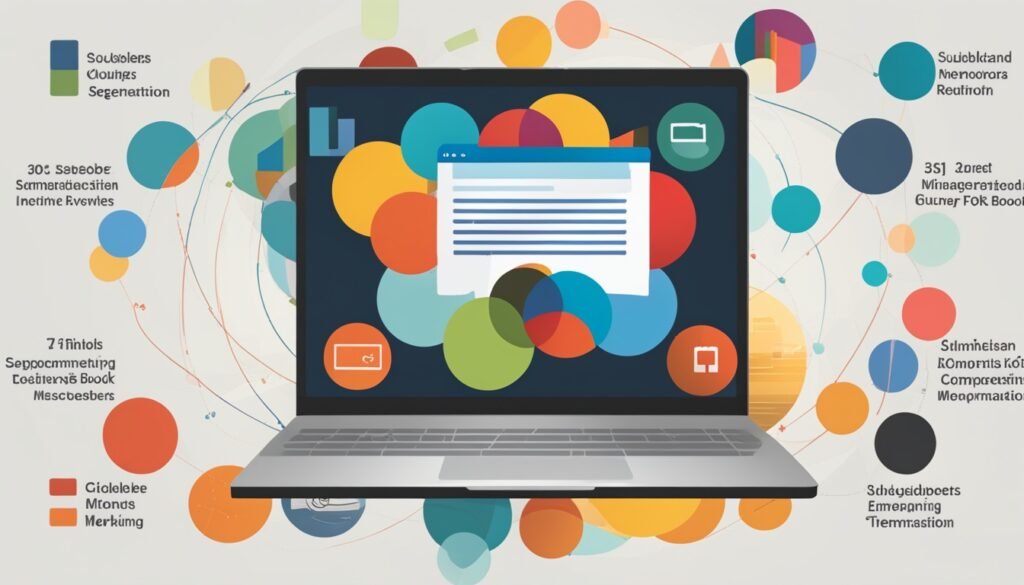Today, email marketing stands strong as a key strategy for connecting with clients. It’s vital for businesses to tweak their approaches. This is due to new rules from big names like Google and Yahoo. They look at how often people open emails, click on them, and ignore them without reading.
Campaign Monitor says the subject line is crucial, affecting 47% of readers’ decisions to open an email. A report by McKinsey & Company shows personalising emails can increase clicks by 10% and sales by 15%. Short, sweet subject lines matter more than you think because phones cut off long ones.
Since most people read emails on their phones, making emails look good on these devices is key. Email tools can track how well emails do in terms of opens, clicks, and sales. This helps businesses fine-tune their email campaigns.
Email marketing is not only effective but also affordable. It’s great for keeping in touch with customers, warming up potential leads, and boosting sales. Yet, companies must be well-prepared to navigate email marketing’s complexities successfully.
Key Takeaways
- Email engagement metrics are crucial for deliverability.
- 47% of email recipients open emails based on the subject line.
- Personalisation can significantly uplift click-through and conversion rates.
- Responsive design is essential as most emails are read on mobile devices.
- Data analytics are vital for tracking and improving email marketing campaigns.
Understanding the Importance of Email Deliverability
Email deliverability plays a key role in connecting with your audience. It’s about getting your emails into the subscribers’ inboxes, not the spam folder. This helps improve open rates and overall interaction with your content.
New Deliverability Requirements
Email service providers like Gmail and Yahoo now use advanced algorithms for email deliverability. They look at open rates, click-through rates, and if emails are quickly deleted. High engagement means emails are more likely to reach the main inbox.
About 10 million spam and harmful emails are blocked by Gmail every minute. This highlights why following email standards is crucial. Using authentication methods like SPF, DKAM, and DMARC is essential for good deliverability.
Factors Affecting Deliverability
Several factors impact email deliverability:
- Sender Reputation: A good reputation, earned by high-quality content and reader engagement, is critical. A bad reputation can result in emails being blocked or marked as spam.
- Email Content: Deliverability improves with engaging, relevant content. Active engagement signals to email algorithms that your messages are valued by subscribers.
- Mailing List Quality: It’s important to keep your email list clean and active. This means avoiding old or non-responsive emails to prevent deliverability problems.
- Authentication: Trust with ISPs is built through proper email authentication. Using protocols like SPF, DKIM, and DMARC is key.
- Subscriber Preferences: Letting subscribers set their email preferences can boost engagement and lower spam complaints. It makes sure emails meet your audience’s needs and interests.
Striking the right balance among these factors can greatly enhance email delivery performance, making sure your messages effectively reach your audience.
| Key Metrics | Importance |
|---|---|
| Open Rate | Indicates the effectiveness of your subject lines and engagement by showing how many subscribers open your emails. |
| Click-Through Rate | Reflects how engaging your content is by showing the percentage of users who click on email links. |
| Delivery Rate | Essential for understanding your email’s reach by tracking the number of emails successfully delivered. |
| Unsubscribe Rate | Helps gauge content relevance and appropriateness by showing how many subscribers opt out. |
| Spam Complaint Rate | Affects your sender reputation by showing how many recipients report your emails as spam. |
| Inbox Placement Rate | Shows how often your emails are placed in the main inbox, not spam folders. |
Having effective email deliverability strategies is key to keeping engagement high. It ensures your marketing efforts pay off by avoiding the spam folder.
Effective Subscriber Segmentation Techniques
Subscriber segmentation is key in sending the right content to different parts of an email list. By using advanced segmentation, you get better engagement and a higher return on investment. This is because the content is more tailored.
Demographic Segmentation
When we talk about demographic data, we mean age, gender, income, and job. Using these details helps marketers send emails that speak to specific groups. 58% of all revenue comes from emails that are targeted and personalised. Brands like Lululemon and Crayon use this approach well. They make their welcome emails more engaging for new subscribers.
Behavioural Segmentation
Behavioural segmentation goes deeper into past buying habits and how people interact with emails. It gives clues about what customers like. This helps tailor email campaigns to match personal interests. For example, basing your email list segments on what people have bought or how they engage with emails can boost your open and click-through rates. Such campaigns usually see a 46% higher open rate.
Tools like Mailchimp and OptinMonster are great for making targeted opt-in forms. These forms help in effective segmentation.
Behavioural segmentation has many benefits:
- It makes content more relevant.
- Open and click-through rates go up.
- Conversion rates improve.
- Unsubscribe rates go down.
- It helps keep customers.
- Resources are used more efficiently.
Segmenting emails, whether by demographics or behaviour, makes your email marketing more personal and effective. Knowing and using these techniques can lead to big growth in email marketing ROI.
| Segmentation Technique | Main Benefits | Example Brands |
|---|---|---|
| Demographic Segmentation | Targeted emails, increased relevance, higher revenue | Lululemon, Crayon |
| Behavioural Segmentation | Improved engagement, higher open and click-through rates | Mailchimp, OptinMonster |
Personalisation Strategies in Email Marketing
Personalisation in email marketing starts by using subscriber data effectively. Marketers craft emails that feel personal to each reader. They use data to send relevant content and *product recommendations* that match each person’s likes, boosting engagement and ROI.
Use of Subscriber Data
Emails can be more personal than just saying someone’s first name. Adding a first name in the subject boosts open rates by 26%. Companies analyse subscriber data to tailor emails perfectly. They suggest products based on what you’ve bought before or where you live.
Marketers use purchase history and how you use their website to send *personalised emails*. They might send special offers on your birthday or anniversary. These touches make you feel special and make the emails more relevant. Also, 80% of people are more likely to buy from brands that do personalised marketing.
Customised Content
Customising email content can really get more people engaged. Personalised images can up click-through rates by 29%. Using what they know about how you use their site, emails are sent when you’re most likely to be interested, boosting engagement by over 75%.
Dynamic content sends messages that hit the mark for each subscriber. Amazon is a master at suggesting what to buy next, thanks to your browsing and buying history. Emails like these get six times more transactions than basic ones.
| Impact of Personalisation | Percentage Increase |
|---|---|
| Open Rates with Personalised Subject Lines | 26% |
| Click-Through Rate with Personalised Images | 29% |
| Engagement with Behavioural Segmentation | 75% |
| Likelihood to Purchase with Personalised Marketing | 80% |
Email personalisation is a key strategy, not just a trend. By tapping into subscriber data and creating tailored content, businesses can improve relevance and engagement. This approach boosts retention and ups revenue.
Crafting Compelling Subject Lines
Crafting compelling subject lines is crucial. They are the first thing recipients see, influencing if they open an email. Open rates measure audience response to email campaigns. Subject lines are key to boosting these rates. Adding personal details like the recipient’s name boosts engagement. Also, tailoring emails to customer preferences increases relevance and interest. For example, Bank of America saw a 26% growth in digital sales by personalising emails with AI.
Subject lines should be clear, to the point, and catchy. The best length for them is about 40-50 characters. Still, both shorter and longer subject lines can work well. The context matters a lot. Creating a sense of urgency or curiosity can also increase open rates. During holidays, emails can have fun and festive subject lines that speak directly to the recipient’s interests.
A/B testing is very important for finding the best subject lines. In 2022, 47% of marketers tested different ones to improve email success. A/B testing shows which subject lines get more opens. For cold emails, making them personal, intriguing, and valuable encourages action. It is also crucial to proofread subject lines to stay professional and keep open rates high.
Here’s a quick guide to making subject lines work:
- Make them clear and without any unnecessary words.
- Add a personal touch by including the recipient’s name or likes.
- Use A/B testing to discover what works best.
- Add elements of urgency, curiosity, or offer something valuable.
- Make sure they look good on mobile phones, keeping them under 50 characters.
| Type of Subject Line | Characteristics | Effectiveness |
|---|---|---|
| Welcome Emails | Friendly, engaging | Highest open rates |
| Reminder Emails | Clear, action-oriented | High engagement rates |
| Cold Emails | Personalised, intriguing | Good for generating interest |
| Promotional Emails | Festive, creative | Boosts open rates during holidays |
Essential Best Practices for Email Campaigns
Email marketing is key for connecting with potential customers, as 94% of marketers believe. It’s crucial for their goals. Permission-based emailing, sending messages at the right time, and making emails look good on any device are vital for success.
Permission-Based Emailing
Getting permission through permission-based emailing cuts spam complaints and boosts your reputation as a sender. Mailchimp suggests using a double opt-in method. This ensures subscribers really want your emails, leading to better deliverability and engagement. A clean list also gives you more opens and clicks, reducing spam complaints and people unsubscribing.
Optimal Send Times
The timing of your email can greatly affect engagement. Studies show emails sent on Tuesdays perform best. Match your sending time with when your audience is most likely to be online. This is based on analyzing your campaign reports. By doing so, you’ll increase clicks and get better results. Marketers have found that solving low open rates (a major issue for 32%) requires smart scheduling.
Email Design and Layout
Since 30% of marketers stress the importance of mobile-friendly emails for better click rates, adopting a responsive design is essential. With people spending about nine seconds viewing an email, your message must be attractive and easy to read on any gadget. Using tools to check how emails look on different devices is a must. This avoids bad layouts that could lead to many unsubscribing.
By incorporating these best practices, from analyzing unsubscribe reasons to maintaining permission-based lists, you can make your email campaigns more focused, efficient, and engaging.
Newsletter Management for Ongoing Engagement
Managing newsletter campaigns well is crucial for keeping your audience engaged and loyal. Personalised messages can make up to 58% of total revenue. This shows the importance of making content suit each person’s interests. Knowing who your audience is and analysing data helps tailor your content strategy.
Being consistent is vital for newsletters. They should come out regularly, so they’re not overlooked. This keeps your readers looking forward to your news and helps them feel connected.
Grouping your audience by their likes, where they live, how they behave, and what they prefer helps a lot. It lets you send messages that really speak to them. This means your newsletter campaigns will connect better, getting your readers more involved.
| Key Factors | Impact on Engagement |
|---|---|
| Personalised Messages | Generate up to 58% of total revenue |
| Segmented Audiences | Increase interaction rates significantly |
| Consistent Schedule | Prevents emails from being ignored or missed |
Automation can make managing newsletters easier. Triggered emails save time and keep readers interested. Welcome emails, transactional messages, re-engagement, and feedback requests arrive just when needed. This boosts both engagement and conversions.@p>
Using these strategies makes your newsletter campaigns great for engagement. They help keep your subscriber list strong and engaged over time.
Boosting Email Conversion Rates
Improving your email marketing starts with focusing on conversion rates. By refining your calls-to-action (CTAs) and ensuring your content matches your conversion aims, you’ll boost your marketing success.
Making Engaging Calls-to-Action (CTAs)
Making your CTAs engaging is crucial for more interactions. A CTA that’s personalised can boost conversions by over 200%. This shows it’s a powerful strategy in email marketing. Below are tips to make your CTAs more effective:
- Personalisation: Tailoring CTAs can lead to 202% better conversions than generic messages.
- Clarity and Placement: Your CTAs should be easy to understand, appealing, and well-placed.
- Use of Colour: Different colours can trigger various emotions, affecting how people engage.
Adding a sense of urgency and exclusivity can encourage prompt responses. Also, split testing helps find the best elements for your CTA, boosting conversion rates.
Aligning Content with Conversion Goals
Aligning your content with conversion goals is key to boosting rates. Making sure your email content fits your goals helps your campaign’s success. Here are strategies to consider:
- Customise email content using customer data for better open rates.
- Ensure emails are mobile-friendly as many open emails on mobile devices.
- Link to landing pages with relevant, personalised content to lower bounce rates.
By aligning your content with your goals and using engaging CTAs, you can improve interactions and see big gains in your email marketing efforts.
Email Analytics: Measuring Engagement
Email analytics are key for marketers to understand how well their campaigns are doing. By looking closely at these numbers, companies can get good insights to make their emails better and drive more results. It’s time to look at the most important metrics for tracking engagement and how they help improve your email strategies.
Key Metrics to Track
Monitoring key metrics is crucial for any successful email campaign. These metrics tell you how engaging your emails are to your audience:
- Open Rate: This shows the percentage of people who open your emails. It’s important for checking if your subject lines work and when is the best time to send emails. The usual open rate is 25%, but some brands like Starbucks have a lower rate of 15.48%.
- Click-Through Rate (CTR): This is the percentage of readers who click on a link in your email. CTR is usually between 2-5%. For instance, Starbucks had a CTR of 1.69%, showing they have room to grow.
- Click-to-Open Rate (CTOR): This measures how many clicks you get versus how many open your emails. It helps understand how engaging your content is. The average CTOR is 10.01%, with Starbucks doing slightly better at 10.69%.
- Conversion Rate: This tracks how many people took the action you wanted, like buying something. A good conversion rate shows your campaign is working well.
- Bounce Rate: This metric separates soft bounces (like inbox issues) from hard bounces (bad email addresses). A lower bounce rate means your email list is clean and well-managed. A good rate is around 2%.
- Unsubscribe Rate: It’s crucial to watch how many people unsubscribe to keep a healthy email list. A high rate could mean your content isn’t matching your audience’s interest.
- Spmam Complaint Rate: Keeping the spam complaint rate below 0.02% is vital to avoid penalties. A low rate means your emails are reaching the inbox and keeping readers happy.
Using Data to Refine Strategy
Using the data from email analytics helps make your campaigns stronger. Here are ways to use this info:
- Segment Audiences: Divide your audience based on how they interact with your emails. Then, customize your messages to fit their needs better.
- Optimise Send Times: Check when people usually open your emails to find the best time to send them. This increases your chances of getting noticed.
- Content Personalisation: Use what you know from email analytics to make your content more interesting and relevant for your readers.
- Adjust Frequency: Look at how often people unsubscribe or report spam to find the right balance. You want to keep in touch without annoying your audience.
| Metric | Industry Average | Starbucks Performance |
|---|---|---|
| Open Rate | 25% | 15.48% |
| Click-Through Rate | 2-5% | 1.69% |
| Click-to-Open Rate | 10.01% | 10.69% |
| Conversion Rate | Varies | N/A |
Email analytics give deep insights into campaign performance. With 66% of internet users buying something because of an email, these metrics are very important. By always improving based on data, companies can make their email marketing much stronger.
Utilising Email Automation for Efficiency
Email marketing is essential today, and email automation is key for success. It lets businesses set up automatic campaigns to send out timely, relevant emails easily. This boosts email efficiency and improves experiences for subscribers.
Automation Tools and Platforms
Many tools exist to streamline email marketing. They handle tasks like sending welcome emails, birthday wishes, and follow-up messages automatically. Tools like Mailchimp, Klaviyo, and ActiveCampaign are popular for automating workflows, segmenting audiences, and testing responses.
These platforms integrate with CRM systems, social media, and eCommerce sites, cutting down manual tasks. They offer analytics on email performance, helping marketers make better decisions and tweak campaigns quickly.
Setting Up Automated Campaigns
Marketers need to plan carefully to create effective automated campaigns. By grouping subscribers, content can be tailored, making messages more engaging. Personalised emails enhance subscriber experiences significantly.
Many platforms have ready-made templates for various campaigns. These templates save time and maintain brand consistency. Automated campaigns can include dynamic content that resonates more with individual preferences, increasing engagement and conversions.
Email automation has many benefits, from saving time to allowing marketers to concentrate on strategy and creativity. These platforms come with collaboration tools, making it easier to manage templates and approvals. Email automation helps businesses grow their strategy and manage more customers efficiently, improving email marketing results.
Conclusion
Email marketing has revealed many strategies and techniques for success. With over 361 billion emails sent daily, it’s clear that having a solid plan is essential. By 2025, we’ll see about 376 billion emails a day. This channel, effective for every dollar spent, brings $42 back. It is crucial for boosting brand awareness, creating leads, and driving sales.
Personalising emails is key. If you use a person’s name in the subject, opening rates can go up by 26%. Emails made just for the reader can push transaction rates up six-fold. Also, segmenting your audience can boost email revenue by a massive 760%. But, 70% of brands still don’t personalize their emails. They’re missing out on big opportunities.
Email marketing is also great because it can change as your business grows. You can tweak campaigns to meet new goals. The right method, like segmenting your audience or making emails look good on phones, increases opens and clicks. Doing email marketing well can secure your company’s growth and keep customers loyal. Want to learn more? Check out SuperOffice’s Email Marketing Strategy guide. Or, discover how to generate leads with email at this useful link.



